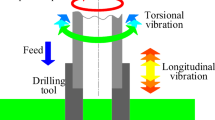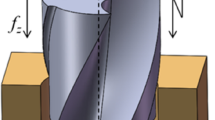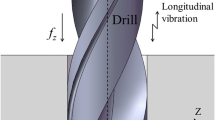Abstract
Ultrasonic vibration assisted drilling (UAD) is used for brittle materials machining for many years, but the processing mechanism in UAD is still not clear, especially in edge chip** damage aspect. A new cutting force model is presented for UAD in this paper, and the cutting force forming and changing can be clearly described in drilling process. Depending on the mathematic model, the entering hole cutting force and exiting hole cutting force can be predicted, the exit edge chip** damage phenomena can be theoretically relieved due to the cutting force control. The variable cross section drilling tool is used for verify the theoretical deduction, and significant improvement in hole exit shape accuracy is presented by the experiment results. In order to reveal the working function of ultrasonic energy, the dynamic relationship between ultrasonic parameters and drilling parameters is carried out. The influence of processing parameters on drilling quality is analyzed in theory and validated by experiment. Smaller edge chip** size and good surface integrity can be obtained by process technology optimizing.













Similar content being viewed by others
References
Cheng J, Yin GQ, Wen Q, Song H, Gong YD (2015) Study on grinding force modelling and ductile regime propelling technology in micro drill-grinding of hard-brittle materials. J Mater Process Technol 223:150–163
He JF, Guo ZN, Lian HS, Liu JW, Zhen Y, Deng Y (2019) Experiments and simulations of micro-hole manufacturing by electrophoresis-assisted micro-ultrasonic machining. J Mater Process Technol 264:10–20
Arif M, Rahman M, San WY (2011) Analytical model to determine the critical feed per edge for ductile–brittle transition in milling process of brittle materials. Int J Mach Tools Manuf 51:170–181
Wang Y, Lin B, Wang SL, Cao XX (2014) Study on the system matching of ultrasonic vibration assisted grinding for hard and brittle materials processing. Int J Mach Tools Manuf 77:66–73
Wang Y, Sarin VK, Lin B, Li H, Gillard S (2016) Feasibility study of the ultrasonic vibration filing of carbon fiber reinforced silicon carbide composites. Int J Mach Tools Manuf 101:10–17
Wang JJ, Feng PF, Zhang JF, Zhang CL, Pei ZJ (2016) Modeling the dependency of edge chip** size on the material properties and cutting force for rotary ultrasonic drilling of brittle materials. Int J Mach Tools Manuf 101:18–27
Wang JJ, Feng PF, Zhang JF, Zhang JF (2016) Improving hole exit quality in rotary ultrasonic machining of ceramic matrix composites using a compound step-taper drill. Cream Int 42:13387–13394
Wang JJ, Feng PF, Zhang JF (2018) Reducing edge chip** defect in rotary ultrasonic machining of optical glass by compound step-taper tool. J Manuf Process 32:213–221
Popli D, Gupta M (2018) A chip** reduction approach in rotary ultrasonic machining of advance ceramic. Mater Today Proceed 5:6329–6338
Kataria R, Kumar J, Pabla BS (2015) Experimental investigation into the hole quality in ultrasonic machining of WC-Co composite. Mater Manuf Process 30:921–933
Feng PF, Wang JJ, Zhang JF, Zheng JZ (2017) Drilling induced tearing defects in rotary ultrasonic machining of c/sic composites. Cream Int 43:791–799
Ding K, Fu YC, Su HH, Chen Y, Yu XZ, Ding GZ (2014) Experimental studies on drilling tool load and machining quality of C/SiC composites in rotary ultrasonic machining. J Mater Process Technol 214:2900–2907
Yuan SM, Zhang C, Amin M, Fan HT, Liu M (2015) Development of a cutting force prediction model based on brittle fracture for carbon fiber reinforced polymers for rotary ultrasonic drilling. Int J Adv Manuf Technol 81:1223–1231
Liu JW, Baek DK, Ko TJ (2014) Chip** minimization in drilling ceramic materials with rotary ultrasonic machining. Int J Adv Manuf Technol 72:1527–1535
Abdallah A, Mohab H, Hassan EH (2019) Experimental investigation of the cutting forces and edge chip** in ultrasonic-assisted drilling of soda glass. Int J Adv Manuf Technol 100:1433–1449
Lawn BR, Marshall DB, Evans AG (1980) Elastic/plastic indentation damage in ceramics: the median/radial crack system. J Am Ceram Soc 63:574–581
Timoshenko S, Goodider JN (1970) Theory of elasticity. McGraw-Hill, New York
Funding
The authors were supported by the Tian** Natural Science Foundation (18JCQNJC05200, 17JCYBJC42400), Tian** Municipal Education Commission Scientific Research Project (2018KJ116), and National Natural Science Foundation (51505334).
Author information
Authors and Affiliations
Corresponding author
Additional information
Publisher’s note
Springer Nature remains neutral with regard to jurisdictional claims in published maps and institutional affiliations.
Rights and permissions
About this article
Cite this article
Wang, Y., Lin, B., Dong, Y. et al. Mechanism modeling and validation in ultrasonic vibration assisted drilling with variable cross section drilling tool of brittle materials. Int J Adv Manuf Technol 103, 3137–3149 (2019). https://doi.org/10.1007/s00170-019-03762-7
Received:
Accepted:
Published:
Issue Date:
DOI: https://doi.org/10.1007/s00170-019-03762-7




